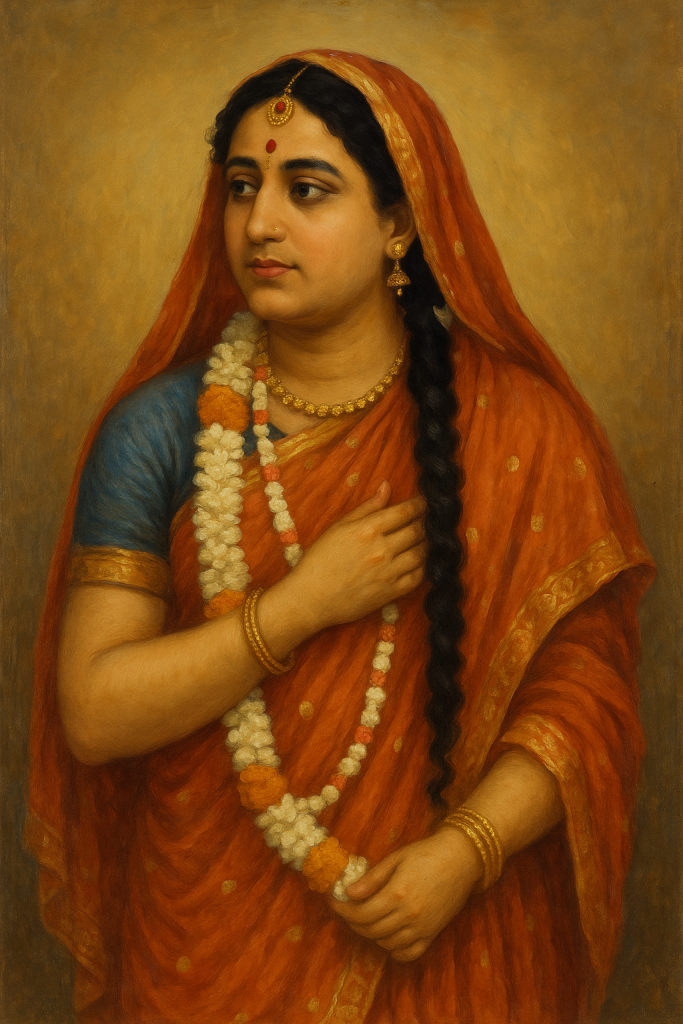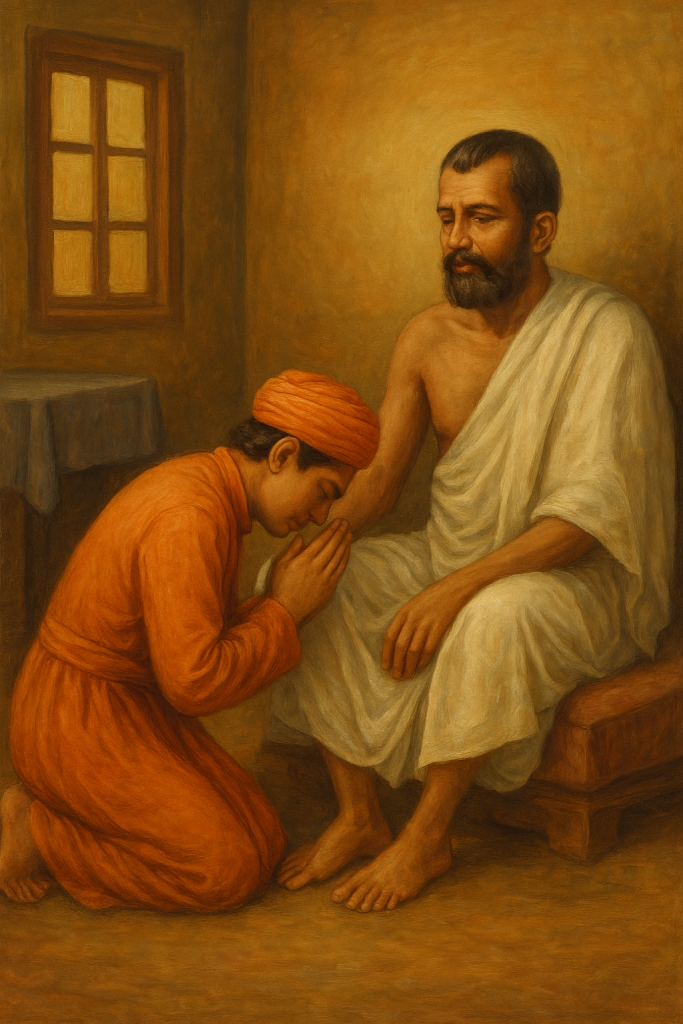Table of Contents
ToggleA Humorous Challenge to Social Norms
It was in the 1880s that an Indian had challenged the social customs in the most humorous and simple way. Science was lagging far behind when Sri Ramakrishna had explored and experienced some of today’s popular concepts of gender fluidity, MPD (Multiple Personality Disorder), dualism, ecstatic yoga, astral projection, and much more.
Interesting facts about Ramakrishna Paramahamsa

Exploration of Multiple Religions: Ramakrishna uniquely practiced various religious paths firsthand, including Tantra, Vedanta, Bhakti, Islam, and Christianity, demonstrating through personal experience that all religions lead to the same ultimate truth
Marriage to Sarada Devi: In 1859, he was married to Sarada Devi, who became his spiritual companion. The marriage was never consummated, reflecting his celibate lifestyle
A Mystic Unlike Any Other
In a world where the thought of spirituality evokes fear in today’s generation, imagine a person who is immensely food-lusty, plays with deities, and has the urge to experience every facet of other religions—yet becomes the most celebrated mystic of all time. Known popularly as Sri Ramakrishna, he is everything one can think of—but an incarnation of the Almighty. He is poor, immensely crazy, and unfathomably simple, with one of the most unlikely attributes for one into spiritual explorations—his uncontrollable greed for food.
Can a Divine Incarnation Be Greedy?
But how can a person considered the incarnation of God—or even a mystic—be greedy? Indian history is full of mysteries, and the land is endowed with magic and miracles. Time and again, we are shown that magic happens only when you are crazy enough to demand it. The path to true enlightenment is a long one that requires constant introspection, self-discovery, and rigorous practice. But if you do it right, you will eventually find yourself gazing at the face of God—and that’s exactly what happened to Sri Ramakrishna Paramahamsa.
From Kamarpukur to Spiritual Eminence
He was born in 1836 in India, and it was only after he spent years in meditation and spiritual contemplation that he experienced his first vision. Ramakrishna’s life is a story of passion, devotion, and spiritual enlightenment. His teachings are still relevant to this day—he taught his disciples to respect all forms of life and unite with God through love and simplicity.
An Unschooled Man Who Became a Guru
Let’s see how an unschooled man from Kamarpukur in West Bengal grew up to be the spiritual guru to some timeless personalities, including the influential Brahmo Samaj leader Keshav Chandra Sen and the Indian youth icon Swami Vivekananda. While our education system believes in the supremacy of theories and systematic schooling, we have people like Shakespeare and Rabindranath Tagore who remained unschooled and time and again proved us wrong by excelling in varied dimensions of true education.
From Temple Priest to Spiritual Revolutionary
The former learnings of the school had always felt distasteful to Ramakrishna Paramahamsa. Therefore, his brother Ram Kumar handed him the priestly responsibilities of the Dakshineshwar Kali Temple in Kolkata. It was during those times when Hinduism in India was facing a spiritual crisis, leading to the predominance of young Bengalis embracing Brahmoism and Christianity. Sri Ramakrishna wasn’t an exception—he succumbed to the invitation to explore other religions.
Breaking Boundaries: Gender Fluidity and Religious Exploration
Being a Hindu, he not only explored other religions like Islam and Christianity but also practiced its various facets, such as Bhakti Yoga, Tantra, and Vedanta. He surprised society by addressing himself in a woman’s attire for several days and regarding himself as one of the gopis in Vrindavan.

Obviously, he was almost discarded by society, who considered him crazy, dumb-headed, a sinner, and much more. Imagine this happening during a time when concepts of psychological androgyny were considered no less than severe social threats.
A Pioneer of the Bengali Renaissance
He has always been contemporary and is considered one of the main contributors to the Bengali Renaissance. While a spiritual destiny was believed to be spent away from the opposite sex, Ramakrishna believed that if the soul has to be free from materialistic desires and follow the path of sannyas, one must consider the divine image of the mother in every woman.
True Renunciation Through Service
This could lead to true and gradual renunciation rather than performing austerities and enforcing a sudden opposing will on the mind. Therefore, he always emphasized service to other women rather than tapasya. In his own lifetime, he proved its authenticity by worshiping his wife and declaring her the embodiment of the Divine Mother.
A Childlike Saint Who Saw Money as Earth
Even when he spent all his life in poverty, the sight of money used to irritate him. It didn’t mean he was any less ambitious than most of us—but he aspired to fathom something beyond monetary abilities. He considered money as equal to earth, and in a childlike glee, he used to throw coins and some soil into the river, calling “Taka mati, mati taka” (Money is soil, soil is money).
A Spiritual Scientist
He was indeed a “Chira-sannyasi”—detached from all materialistic desires while being attached to the immensity that life could offer him. Ramakrishna came to teach the religion of today—which is constructive, the one that isn’t only about scriptures and blind faith, destructive or absurd. He was indeed a spiritual scientist—one who speculated, conducted experiments, and only then, based on the results obtained, drew conclusions and put forth his theory before the scientific world for its acceptance.
“I See, and You Too Can See”
He had to go afresh to nature to ask for facts, and he got scientific religion—which never says “believe” but “see.” “I see, and you too can see,” he used to say. “Use the same means, and you will reach the same vision. God will come to everyone. Harmony is within the reach of all.”
Proving God’s Existence to Vivekananda
For instance, when Swami Vivekananda visited him, he asked for proof of the existence of God. “I have seen Him just as I see you here, only in a much more intense sense,” the mystic reassured.

“God can be realized.” Hearing this rare, spontaneous assurance from the depth of one’s realizations, even Swamiji thought him to be a monomaniac—a madman. After all, we seldom find people who dare to affirm the existence of God through countless self-realizations.
The Power of a Simple Touch
Not only that, but this man with messy beards and nothing remarkable about him apart from his striking simplicity said, “I can show you if you have enough courage.” He then placed his foot on Vivekananda’s chest and pushed him into a state of samadhi, where he remained unconscious of his surroundings for hours. When he came back to his normal state, he was no longer the person he used to be.
A Guru Who Welcomed Testing
Sri Ramakrishna always tested his disciples and had asked them to test him in return. Unlike some of the so-called spiritual masters today, Ramakrishna had only 16 disciples, and he hardly harbored the desire to gain fame in this material world. However, his teachings were so valuable to the planet that it had to sort its way through an apprentice.
The Birth of the Ramakrishna Order
After the death of their master, the monastic disciples, led by Vivekananda, formed a fellowship at a half-ruined house, which later constituted the first Ramakrishna Order—something that opened a thousand gateways of immense possibility for millions of people.
A Global Legacy
His teachings weren’t kept under wraps within India but have been carried far and wide by Swamiji as he traveled between 1893 to 1897 and 1899 to 1902 in America and England, conducting lectures and classes.
“Sisters and Brothers of America!”
He delivered two lectures in New York and England (1901) on Ramakrishna. His famous speech at Chicago and his immense contribution to the betterment of humankind have all been revered and dedicated to his master. As Vivekananda said, “All that I am, all that the world itself will someday be, is owing to my master.”
Conclusion: The Eternal Light of Ramakrishna’s Wisdom
Sri Ramakrishna Paramahamsa was not just a mystic or a saint—he was a spiritual revolutionary who shattered rigid dogmas with childlike simplicity and fearless experimentation. In an era bound by orthodoxy, he embraced divine madness, transcending religious, social, and psychological barriers to prove that truth is universal.
His life was a living testament to the idea that God is not confined to scriptures or rituals but is an experiential reality—visible to those who seek with sincerity. Through his unorthodox methods—whether dressing as a woman, practicing multiple faiths, or throwing coins into the river—he demonstrated that spirituality is not about rigid discipline alone but about love, playfulness, and direct experience.
Ramakrishna’s greatest legacy lies in his disciples, particularly Swami Vivekananda, who carried his message of universal harmony to the world. His teachings continue to inspire millions, reminding us that divinity is not distant but accessible to all—through devotion, self-inquiry, and above all, an open heart.
In the end, Ramakrishna was neither mad nor merely divine—he was a mirror, reflecting the boundless possibilities of human consciousness when it dares to break free from fear and limitation. His life challenges us to question: If a poor, unschooled man from a village could touch the infinite, what stops us?As we navigate the complexities of modern life, his message remains timeless—“See God in all, love without limits, and dare to experience truth for yourself.”





